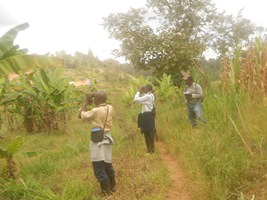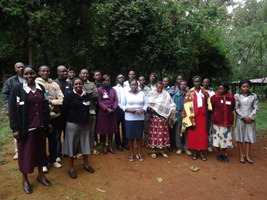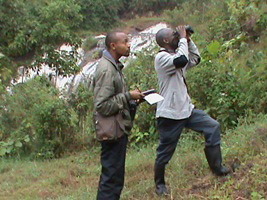|
Cycle 1 (2011 Deadline)
Natural pest and weed supression functions by birds as incentives to conserve a globally threatened bird species and enhance livelihoods in an agricultural landscape PI: Peter Njoroge, National Museums of Kenya U.S. Partner: Matthew Johnson, Humboldt State University Project Dates: May 2012 - May 2015 Project Overview Biodiversity in agricultural landscapes can be part of the solution to problems in the food production sector, as most biodiversity hotspots lie outside nature reserves. New technical research that promotes the mutual relationship between agriculture and conservation is therefore needed. This project aimed to investigate the interactions between agricultural systems and functional bird groups in the Mukurweini district of Kenya.
Located in the central Kenya highlands, Mukurweini district is a globally recognized Important Bird Area (IBA) within an intensively cultivated landscape. The research team used birds to understand the influence of landscape composition in Mukurweini on occurrence of natural pest enemies and post-dispersal weed predators.
This study identified and promoted the best landscape composition features in Mukurweini to increase the occurrence of functionally important birds (e.g., pest- and weed seed-eating). Dr. Johnson, the U.S. collaborator on the project, served as the lead scientific coordinator for the exclosure experiments. He has extensive experience with bird exclosure experiments, including their design, deployment, data collection, analysis and interpretation.
The research sought to benefit the conservation of globally threatened bird species like the Hinde’s Babbler, improve food security and livelihoods in rural settings, and help boost the growth of bird watching tourism in Kenya.
Final Summary of Project Activities The researchers investigated the interactions between agricultural systems and functional bird groups based on their feeding guilds and recorded 116 species across six months of data collection. Among other findings, the data indicated significantly more species recorded during the wet seasons as compared to the dry season. The PEER team developed close working relationships between local schools, local government, and the Kinyoho women’s group throughout the project. They also brought on board Nature Kenya as the local birdlife partner, which will continue supporting the groups and their initiatives, including an Indigenous tree planting program in schools and the beginning of a tree nursery at Wajee Nature Camp. During the grant period, a Master’s degree candidate on the team finished his coursework, using work done for the research project as part of his thesis.
Researchers presented their results to local farmers at a workshop held at Wajee Nature Camp, as well as in a presentation to members of the Mukurweini Environmental Youth Group and Wildlife Clubs of Kenya. The presentations included information on integrated land-use systems for both profitable food production and protection of critical ecosystems, as well as enhancing landscape-driven natural pest and weed suppression. During the workshops participants proposed several activities that could be undertaken to help promote and disseminate the project results, such as a commercial tree program, school outreach program, bee-keeping program, conservation awareness tournaments, and Mukurweini biodiversity and culture marketing.
Publications
Megan C. Milligan, Matthew D. Johnson, Megan Garfinkel, Chris J. Smith, Peter Njoroge. 2016. Quantifying pest control services by birds and ants in Kenyan coffee farms. Biological Conservation 194: 58-65. https://doi.org/10.1016/j.biocon.2015.11.028
C. Smith, D. Barton, M.D. Johnson, C. Wendt, M.C. Milligan, P. Njoroge, P. Gichuki. 2015. Bird communities in sun and shade coffee farms in Kenya. Global Ecology and Conservation 4: 479-490. https://doi.org/10.1016/j.gecco.2015.09.004
| 





